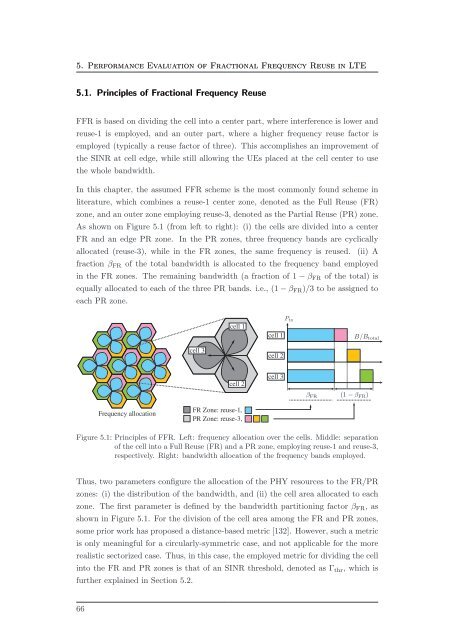System Level Modeling and Optimization of the LTE Downlink
System Level Modeling and Optimization of the LTE Downlink
System Level Modeling and Optimization of the LTE Downlink
- No tags were found...
Create successful ePaper yourself
Turn your PDF publications into a flip-book with our unique Google optimized e-Paper software.
5. Performance Evaluation <strong>of</strong> Fractional Frequency Reuse in <strong>LTE</strong>5.1. Principles <strong>of</strong> Fractional Frequency ReuseFFR is based on dividing <strong>the</strong> cell into a center part, where interference is lower <strong>and</strong>reuse-1 is employed, <strong>and</strong> an outer part, where a higher frequency reuse factor isemployed (typically a reuse factor <strong>of</strong> three). This accomplishes an improvement <strong>of</strong><strong>the</strong> SINR at cell edge, while still allowing <strong>the</strong> UEs placed at <strong>the</strong> cell center to use<strong>the</strong> whole b<strong>and</strong>width.In this chapter, <strong>the</strong> assumed FFR scheme is <strong>the</strong> most commonly found scheme inliterature, which combines a reuse-1 center zone, denoted as <strong>the</strong> Full Reuse (FR)zone, <strong>and</strong> an outer zone employing reuse-3, denoted as <strong>the</strong> Partial Reuse (PR) zone.As shown on Figure 5.1 (from left to right): (i) <strong>the</strong> cells are divided into a centerFR <strong>and</strong> an edge PR zone. In <strong>the</strong> PR zones, three frequency b<strong>and</strong>s are cyclicallyallocated (reuse-3), while in <strong>the</strong> FR zones, <strong>the</strong> same frequency is reused. (ii) Afraction β FR <strong>of</strong> <strong>the</strong> total b<strong>and</strong>width is allocated to <strong>the</strong> frequency b<strong>and</strong> employedin <strong>the</strong> FR zones. The remaining b<strong>and</strong>width (a fraction <strong>of</strong> 1 − β FR <strong>of</strong> <strong>the</strong> total) isequally allocated to each <strong>of</strong> <strong>the</strong> three PR b<strong>and</strong>s. i.e., (1 − β FR )/3 to be assigned toeach PR zone.cell 1cell 1cell 3cell 2cell 2cell 3Frequency allocationFR Zone: reuse-1,PR Zone: reuse-3,Figure 5.1: Principles <strong>of</strong> FFR. Left: frequency allocation over <strong>the</strong> cells. Middle: separation<strong>of</strong> <strong>the</strong> cell into a Full Reuse (FR) <strong>and</strong> a PR zone, employing reuse-1 <strong>and</strong> reuse-3,respectively. Right: b<strong>and</strong>width allocation <strong>of</strong> <strong>the</strong> frequency b<strong>and</strong>s employed.Thus, two parameters configure <strong>the</strong> allocation <strong>of</strong> <strong>the</strong> PHY resources to <strong>the</strong> FR/PRzones: (i) <strong>the</strong> distribution <strong>of</strong> <strong>the</strong> b<strong>and</strong>width, <strong>and</strong> (ii) <strong>the</strong> cell area allocated to eachzone. The first parameter is defined by <strong>the</strong> b<strong>and</strong>width partitioning factor β FR , asshown in Figure 5.1. For <strong>the</strong> division <strong>of</strong> <strong>the</strong> cell area among <strong>the</strong> FR <strong>and</strong> PR zones,some prior work has proposed a distance-based metric [132]. However, such a metricis only meaningful for a circularly-symmetric case, <strong>and</strong> not applicable for <strong>the</strong> morerealistic sectorized case. Thus, in this case, <strong>the</strong> employed metric for dividing <strong>the</strong> cellinto <strong>the</strong> FR <strong>and</strong> PR zones is that <strong>of</strong> an SINR threshold, denoted as Γ thr , which isfur<strong>the</strong>r explained in Section 5.2.66
















